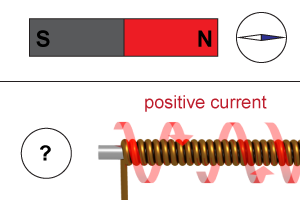|
A magnetic field is created whenever current flows, and a device that turns electrical energy into magnetic energy is called an electromagnet. If current flows through a straight length of wire, the magnetic field at any point is tangential to a circle that is centered upon the wire. A solenoid is a long coil of current-carrying wire, and it generates a magnetic field that resembles a bar magnet’s. Electric motors rely on the attractive and repulsive forces between permanent magnets and electromagnets. For an electric motor to efficiently operate, the electromagnets’ poles must periodically alternate between N and S. The motor then can use electric current to generate torque and perform mechanical work.
For more information to research the development of the concept of the electromagnetic force, see - Hidden Attraction: The History and Mystery of Magnetism by G. L. Verschuur,
- A History of Electricity and Magnetism by H. W. Meyer, and
- The Electric Life of Michael Faraday by A. W. Hirshfeld.

|
|
electromagnetism, electromagnets, polarity, solenoid, electric motor, commutator, armature
|
Review problems and questions |
|
- Research and describe the historical development of the concept of the electromagnetic force.

 |
An essay on the historical development of the electromagnetic force may include- Ørsted’s discovery of the connection between electric current and magnetism;
- Faraday’s discovery of the connection between changing magnetic fields and induced electric current;
- Maxwell’s connection between electric force and magnetic force in his equations; and
- the development of applications of electromagnetic force, such as the generator, transformer, and motor.

|

- You look down upon a current-carrying wire with a cardboard square around it. (Positive current is approaching you.) You place four magnetic compasses on the cardboard stage. Which pattern will you see? (Recall that each red tip has a N polarity.)

 |
You will see Pattern (b). Recall the right-hand rule as applied to current-carrying wires: It instructs us to point the thumb of our right hand in the direction of positive current. The fingers then curl in the direction of the magnetic field made by the current. In turn, magnetic compasses trace the field by aligning themselves as if their red (N) tips pointed in the same direction as the field lines. Look down upon your right thumb and your fingers will coil in a counterclockwise direction, and that is the pattern traced by the compasses shown in Panel (b). 
|

- You have been given an unusually colored magnetic compass. As shown in the top diagram, you place it next to a properly labeled bar magnet to determine what the compass’s white and blue tips represent. Next (bottom diagram), you bring the compass up toward one end (marked “?”) of a solenoid, which is carrying current as shown here. Which way will the blue tip of your compass needle point?

 |
 The blue tip will point toward the solenoid. First, note that the blue tip of the compass was repelled by the N end of a labeled bar magnet. This means that the blue tip has a N polarity. Next, apply the right-hand rule to determine the polarity of the solenoid: This indicates that the left-hand end of the solenoid generates a S magnetic polarity. In turn, that dictates that the blue (N) tip of the compass will be drawn toward the left (S) end of the solenoid.
The blue tip will point toward the solenoid. First, note that the blue tip of the compass was repelled by the N end of a labeled bar magnet. This means that the blue tip has a N polarity. Next, apply the right-hand rule to determine the polarity of the solenoid: This indicates that the left-hand end of the solenoid generates a S magnetic polarity. In turn, that dictates that the blue (N) tip of the compass will be drawn toward the left (S) end of the solenoid. 
|
Take a Quiz |

